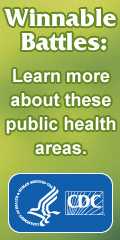April 2017
Did You Know? is a weekly feature from the Office for State, Tribal, Local and Territorial Support to inform your prevention activities. We invite you to read, share, and take action!
View the Current Did You Know?
April 28, 2017
- About 1 in 7 US children aged 2–8 years has a mental, behavioral, or developmental disorder, such as anxiety, learning problems, or attention-deficit/hyperactivity disorder.
- Kids who have these disorders and live in rural areas face personal, financial, and neighborhood challenges more often than those who live in urban areas.
- Rural children and their parents might need additional support from states, healthcare systems, and primary care providers—here’s how to help them thrive.
April 21, 2017
- Vaccination of children born during 1994–2013 will prevent an estimated 322 million illnesses, 21 million hospitalizations, and 732,000 deaths over the course of their lifetimes.
- Following the recommended childhood immunization schedule protects babies and children by providing immunity early in life.
- Healthcare providers and public health professionals can educate patients about the importance of vaccination and staying on schedule using easy-to-read resources recommended by CDC.
April 14, 2017
- Stroke can happen to anyone, but African-Americans and Hispanics face more prevention challenges and are more likely to have a stroke.
- About 1 in 3 US adults has high blood pressure. African-Americans have higher rates than do whites or Hispanics, and they tend to develop high blood pressure at an earlier age.
- Heart disease is the leading cause of death among American Indians and Alaska Natives. Use CDC’s resources to make a difference in your community.
April 7, 2017
- About 1 in 10 US pregnant women with confirmed Zika infection in 2016 had a fetus or baby with birth defects.
- Babies born with Zika-related birth defects require specialized follow-up care and developmental monitoring.
- Health departments can coordinate pregnancy surveillance with Zika birth defects surveillance to ensure all affected babies are identified and families are connected to appropriate medical and social services.
Did You Know? information and web links are current as of their publication date. They may become outdated over time.
- Page last reviewed: April 21, 2017
- Page last updated: April 21, 2017
- Content source:



 ShareCompartir
ShareCompartir



